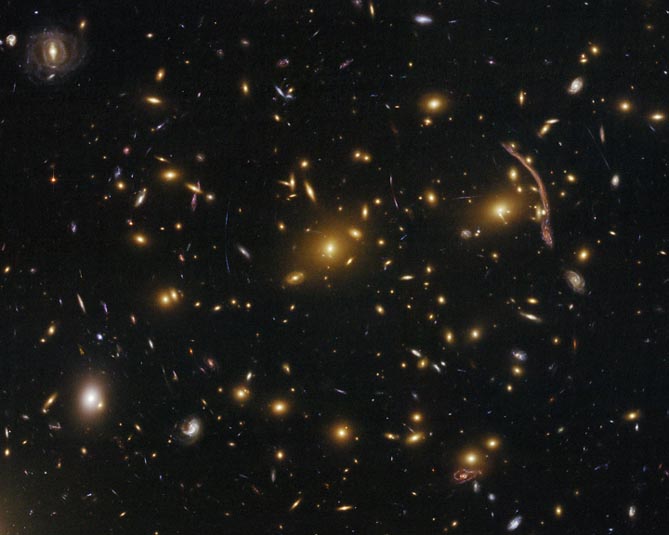
Description: Galaxy Cluster
Position (J2000): RA 02h 39m 49.9s. Dec. -01° 34' 26.7"
Constellation: Cetus
Distance: 4.77 billion light-years (1.46 billion parsecs)
Dimensions: This image is 2.4 arcminutes (3.4 million light-years or 1 million parsecs) wide.
Instrument: ACS/WFC
Exposure Date(s): July 16, 2009
Exposure Time: 3.5 hours
Image Credit: NASA, ESA, the Hubble SM4 ERO Team and ST-ECF
Release date: September 9, 2009
ABOUT THIS IMAGE:
The NASA/ESA Hubble Space Telescope's newly repaired Advanced Camera for Surveys (ACS) has peered across almost five billion light-years to resolve intricate details in the galaxy cluster Abell 370. Abell 370 is one of the very first galaxy clusters where astronomers observed the phenomenon of gravitational lensing, the warping of space-time by the cluster's gravitational field that distorts the light from galaxies lying far behind it. This is manifested as arcs and streaks in the picture, which are the stretched images of background galaxies.
Gravitational lensing is a vital tool for astronomers when measuring the dark matter distribution in massive clusters, since the mass distribution can be reconstructed from observations of its gravitational effects.
Ground-based telescopic observations in the mid-1980s of the most prominent arc (near the right-hand side of the picture) allowed astronomers to deduce that the arc was not a structure of some kind within the cluster, but the gravitationally lensed image of an object twice as far away. Hubble has now resolved new, previously unseen details in the arc that reveal structure in the lensed background galaxy.
Galaxy clusters are the most massive structures of the Universe, located at the crossing of the filaments of the cosmic web of dark matter. The most massive clusters can contain up to 1000 galaxies and intergalactic hot gas, all held together primarily by the gravity of dark matter.
These observations were taken with Hubble's Advanced Camera for Surveys (ACS) in its Wide Field mode on July 16, 2009. The composite image was made using filters that isolate light from green (F475W), red (F625W) and infrared (F814W) wavelengths.
These Hubble data are part of the Hubble Servicing Mission 4 Early Release Observations.
From Wikipedia:
Abell 370 is a galaxy cluster located approximately 6 billion light-years away from the Earth (at redshift z = 0.375), in the constellation Cetus. Its core is made up of several hundred galaxies. It was catalogued by George Abell, and is the most distant of the clusters he catalogued.
Abell 370 appears to include several arcs of light, which in fact are mirages caused by gravitational lensing of more distant objects
In 2002, astronomers used this lensing effect to discover a galaxy, HCM-6A, 12.8 billion light years away from Earth. At the time it was the furthest known galaxy.
In
2009, study in the field of Abell 370 revealed a grouping of background
galaxies lensed and distorted by the cluster into an arc with the appearance
of a dragon, hence nicknamed The Dragon by NASA scientists. Its head is
composed of a spiral galaxy, with another spiral composing the tail. Several
other galaxies form the body of the dragon, all overlapping. These galaxies
all lie approximately 5 billion light years away